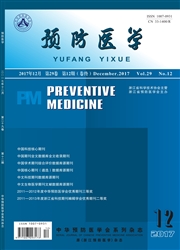

 中文摘要:
中文摘要:
目的分析2011-2015年舟山市发热伴血小板减少综合征(SFTS)的流行特征及发病影响因素.方法从中国疾病预防控制信息系统导出2011-2015年舟山市SFTS疫情数据,描述性分析SFTS的流行病学特征;选择2013-2015年舟山市新发SFTS确诊病例作为病例组,在有SFTS病例报告的村(社区)常住居民中随机选择≥40岁的正常居民作为对照组,采用病例对照研究方法分析SFTS发病的危险因素.结果2011-2015年舟山市共报告SFTS95例,报告发病密度为1.66/10万人年,报告死亡病例9例,病死率为9.47%.舟山市4个县(区)均有病例报告,其中岱山县为高发县(91.58%).5-7月为SFTS发病高峰;病例年龄在40-88岁,其中&50岁者占92.53%,男女性别比为1:1.88,女性SFTS报告发病密度高于男性(P〈0.01);职业以家务待业和农民为主,分别占43.16%和35.79%.多因素Logistic回归分析结果显示,田间/菜地劳作史(OR=2.542,95%CI:1.364-5.621)和室外卫生状况差(OB=2.873,95%CI:1.462-5.025)是SFTS发病的危险因素.结论2011-2015年舟山市SFTS呈散发,具有明显的地区聚集性和季节性,田间/菜地劳作史和室外卫生状况差是SFTS发病的危险因素.
 英文摘要:
英文摘要:
Objective To learn the epidemiological characteristics and risk factors of severe fever with thrombocytopenia syndrome( SFTS) in Zhoushan City from 2011 to 2015. Methods The descriptive epidemiological analysis was used to analyze the epidemiological characteristics and a case- control study was applied to analyze the risk factors. Results A total of 95 SFTS cases including 9 dead cases were reported in Zhoushan City from 2011 to 2015. All of the 4 counties had cases reported,and the county with the highest reported rate was Daishan( 91. 58%). SFTS was seasonal obviously and the epidemic peak presented from May to July. The range of age for these SFTS cases was 40 to 88 years old,and over 50 years old were accounted for 92. 53%. The sex ratio of male to female was 1∶ 1. 88,and the incidence density of SFTS in female was significantly higher than male( P〈0. 01). The main occupation were domestic unemployed( 43. 16%) and farmers( 35. 79%). While using multivariate unconditional logistic regression analysis to filter the influencing factors,only working in the fields / vegetable plots( OR = 2. 542,95% CI: 1. 364- 5. 621) and the outdoor sanitation( OR = 2. 873,95%CI: 1. 462- 5. 025) entered the final model. Conclusion The incidence of SFTS was mainly sporadic in Zhoushan City from 2011 to 2015,having obvious regional aggregation. The popular seasons were spring and summer. Working in the fields / vegetable plots and the poor outdoor sanitation could be the risk factors of SFTS.
 同期刊论文项目
同期刊论文项目
 同项目期刊论文
同项目期刊论文
 期刊信息
期刊信息
